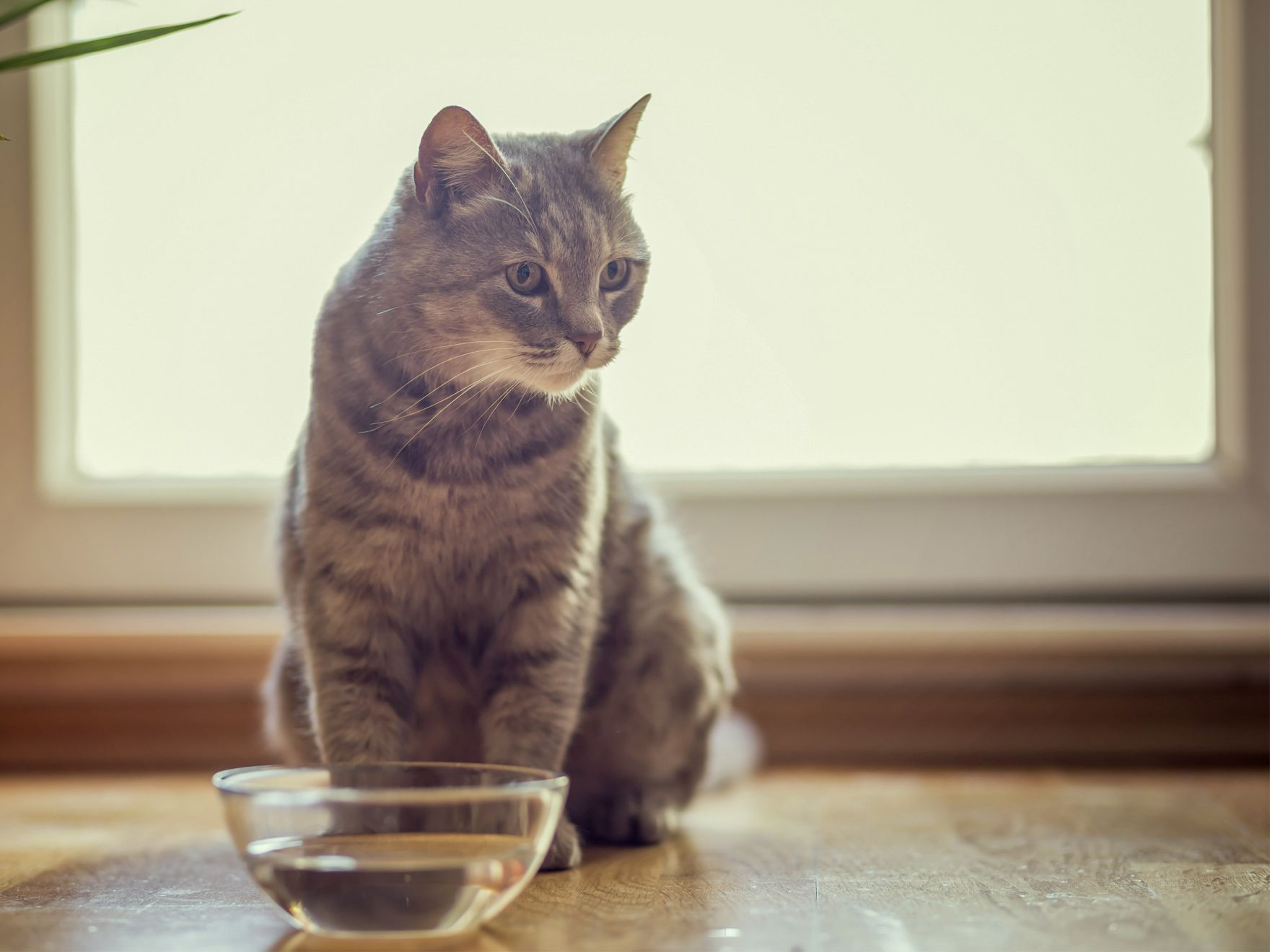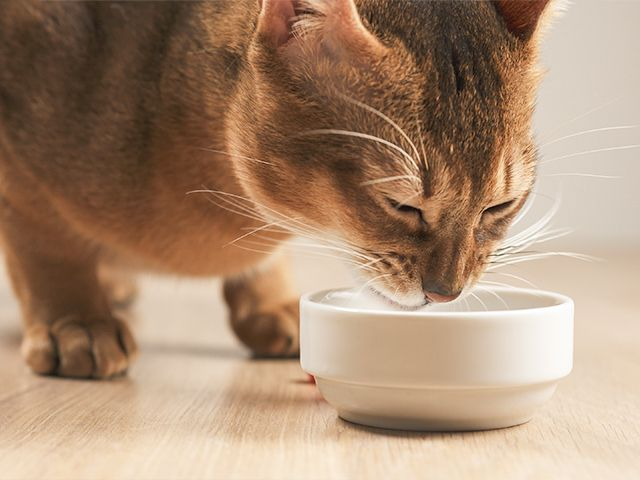Is Your Cat Dehydrated?
Article

Your cat’s ancestors came from the desert. They could survive on very little water and had the ability to concentrate their urine to an incredible degree.
Cats have kept their ancestors’ low thirst drive. This means they don’t always drink when they need to, which makes them susceptible to dehydration. Their concentrated urine also contains less water than the urine of other species, which makes them more prone to developing urinary stones and crystals.
Thankfully, there are things you can do to encourage your cat to drink and help them stay hydrated.

Why water intake is key for your cat’s urinary health
A cat needs water to survive, just like you do. Water lubricates joints, enables digestion, helps maintain body temperature, and facilitates circulation. In fact, almost every bodily function relies on water.
Water is especially vital to your cat’s urinary system, which uses water to flush waste products from the body. Without sufficient water, toxic materials accumulate, which can lead to cat health issues like kidney disease, bladder stones, and FLUTD.
What is dehydration?
Your cat constantly loses fluids throughout the day – as it breathes, sweats, and urinates. Usually, a cat will replace these fluids by drinking fresh water and eating food. When this balance is disrupted, and the cat loses more fluids than it takes in, it becomes dehydrated.
Dehydration is a serious problem because it can lead to imbalances in electrolytes like sodium and potassium, which are needed for proper organ function.
Without enough electrolytes, the organs shut down. This, combined with water loss and a build-up of bodily toxins, can quickly lead to major health problems. Dehydration can also result in circulatory problems.
Even cats with mild dehydration risk developing health issues, as insufficient fluid leads to more concentrated urine, which increases the likelihood of crystals and urinary stones forming.
Causes of dehydration in cats
Dehydration occurs when a cat loses fluids faster than it can replace them.
This can happen because a cat isn’t drinking enough water, but often it’s because they’re losing fluids at an increased rate due to hot weather or an illness. Common causes of dehydration include:
- Diabetes
- Kidney disease
- Vomiting
- Diarrhea
- Fever
- Trauma
- Heatstroke
- Decreased urine production
If your cat is unwell, they may experience a loss of appetite and avoid drinking. This can trigger or worsen their dehydration.
Are some cats prone to dehydration?
Any cat can become dehydrated, but senior cats, kittens, and those with an existing illness like diabetes or kidney disease, have a higher chance of developing dehydration.
How to tell if a cat is dehydrated
The clinical signs of dehydration vary depending upon what’s causing the fluid loss and how severe the cat’s dehydration is. Common signs include:
- Loss of energy
- Weakness
- Tacky or dry gums
- Lack of appetite
- Sunken eyes
- Panting
Cats suffering from dehydration because of an illness may show other signs connected with the condition, like vomiting, diarrhea, or drooling. If your cat is drinking a lot more than usual but still showing signs of dehydration, it may also indicate a problem.
If you suspect your cat has dehydration, try to check their gums. Normally, a cat’s gums feel wet and slimy to the touch. If your cat is dehydrated, the gums may feel tacky and dry.
Another test is to pinch or lift the skin on your cat’s shoulder blades. Usually, the skin will snap back into position in the same way the skin on the back of your hand does when it’s pinched. If the skin is slow to settle, it could be a sign of dehydration.
These tests aren’t conclusive, so if you think your cat is dehydrated or is showing any of the signs we’ve highlighted here, you should contact your vet immediately.
What to do if your cat is dehydrated
There are things you can do around your home to encourage your cat to drink more and stay hydrated. However, if your cat is dehydrated, they need to see a vet.
While some dehydrated cats will continue to drink and eat, they may not be able to consume enough water to compensate for the fluid they’re losing.
Your vet will be able to conduct tests to identify the cause and severity of your cat’s dehydration and recommend the appropriate management options. For milder cases, a vet may recommend subcutaneous fluids (giving fluids into the space under the skin), while cats with severe dehydration may require hospitalization to allow fluids to be delivered directly into their bloodstream through an IV.

Does Your Cat Have Enough Water in Their Diet?
Typically, a cat needs to consume 3.5 to 4.5oz of water for every 5lb of body weight each day.
The desert-dwelling cats of yesteryear would have gotten most of their water through food, but your cat will probably need to drink fresh water to supplement their fluid intake – especially if they only eat dry food.
Your cat’s naturally low thirst drive means they may need some encouragement to drink, and some cats are particularly choosy about the type of water bowl they use.
Here are some tips to get your cat to drink more water:
- Place multiple water bowls around your home. Ideally, they should be on different levels, in calm spots, away from litter boxes and food bowls. Try to avoid corners, as cats like to see their surroundings while they drink.
- Keep the bowls topped up with fresh water. Replace the water completely and wash out each bowl every day.
- Cats have different preferences when it comes to water bowls. Some like a wide, shallow saucer, while others would rather drink from a deeper container. The material of the bowl matters too, so test glass, porcelain, and metal bowls to see which they prefer.
- Some cats only like to drink running water. You should be able to buy a water fountain at your local pet store.
If your cat is averse to drinking or suffering from dehydration, your vet may recommend a wet diet.
While dry food can contain some moisture, wet food has a higher percentage of water content, which can make it easier for a cat to get the fluids they need. Just remember that a change in diet needs to be done gradually to avoid causing food aversion and undue stress.
If your cat has a urinary or bladder problem due to dehydration, your vet will take steps to manage their condition. You can learn more about the management options they may recommend in our Urinary Management and Treatment articles.
Like & share this page